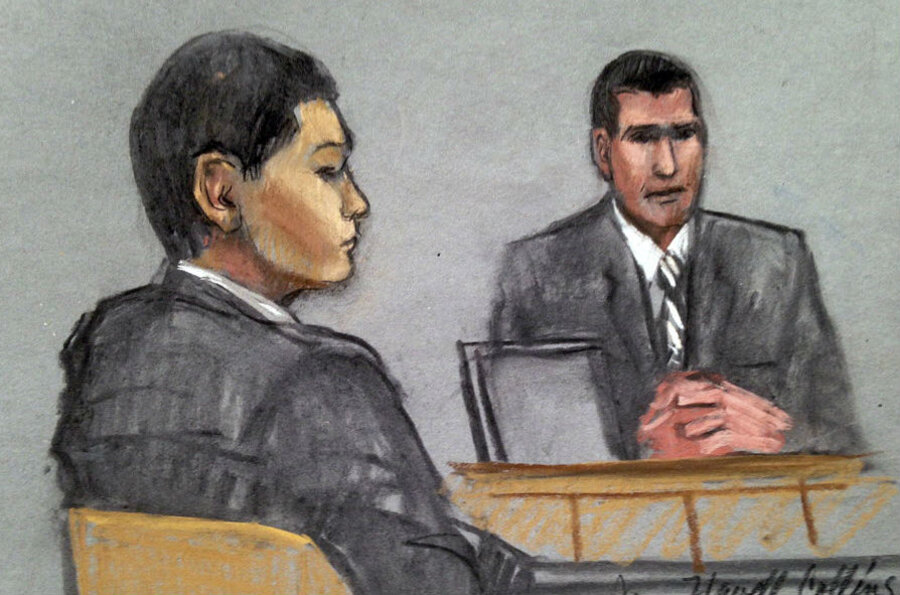Portraits clash of friend of suspected Boston bomber, as trial nears end
Loading...
| BOSTON
Closing arguments in an obstruction of justice case against friend of Boston Marathon bombing suspect Dzhokhar Tsarnaev wrapped up Wednesday in Boston, with the two sides painting different pictures of the defendant.
At issue is whether Azamat Tazhayakov obstructed the federal investigation into the 2013 bombing or whether friends of Mr. Tazhayakov acted alone in attempting to cover Mr. Tsarnaev’s tracks.
Prosecutors said Tazhayakov conspired with two friends, Dias Kadyrbayev and Robel Phillipos, to remove a number of incriminating items – including fireworks emptied of their gunpowder – from the alleged bomber’s college dorm room in Dartmouth, Mass.
Defense attorneys, in response, said Tazhayakov merely watched as Mr. Kadyrbayev removed Tsarnaev’s effects without his aid.
“He’s a friend of a kid who committed a heinous act, and friends of bombers are enemies of ours,” said Matthew Myers, an attorney for defendant Tazhayakov. “Guilt by association – that’s exactly what this case was about.”
Over the course of the trial, which began July 7, the prosecution and defense agreed on the general timeline of events surrounding Tazhayakov's actions, though the two sides often interpreted them in starkly different terms.
According to prosecutors, the earliest evidence of the obstruction charge stems from a text message Tsarnaev sent to Tazhayakov just before 9 p.m. on the day of the bombing that reads, “If yu want yu can go to my room and take what’s there :) but ight bro.”
While defense attorneys say the smiley face is code for marijuana, prosecutors say the text was a signal for Tazhayakov to remove the fireworks from his room.
Later that evening, Tazhayakov, Kadyrbayev, and Mr. Phillipos entered Tsarnaev’s dorm room at the University of Massachusetts, Dartmouth, and Kadyrbayev searched through Tsarnaev’s effects, while Tazhayakov and Phillipos watched television, according to court testimony.
The trio left with Tsarnaev’s backpack, containing the emptied fireworks, a flash drive, headphones, fireworks, a laptop, and an ashtray. Afterward, they drove to the apartment of Bayan Kumiskali, Kadyrbayev’s girlfriend.
Once there, Ms. Kumiskali become angry when she learned the items had been taken from Tsarnaev's room, prompting Kadyrbayev to throw them away, Kumiskali testified at the trial.
At the same time, Tazhayakov searched the Internet for information on Tsarnaev. Later that evening, he texted Kadyrbayev, writing that he thought the authorities had caught Dzhokhar Tsarnaev’s brother, Tamerlan, hours before such information was made public.
While prosecutors say Tazhayakov knowingly decided to have the items in question removed, defense attorneys said he was a passive onlooker who didn’t fully understand the seriousness of the situation.
“The reality is: College kids think differently,” said Mr. Myers, the defense attorney. “I’m not minimizing what happened in this town in the least, but when you’re talking about college kids, you’re talking about a different mind-set.”
Myers also noted that Tazhayakov left many incriminating items behind in Tsarnaev’s dorm room, including a white baseball cap Tsarnaev was wearing in FBI photos released to the public.
Since August 2013, Tazhayakov, Kadyrbayev, and Phillipos have been held without bail on charges of obstruction of justice, which carries a prison sentence of up to 25 years.
Tsarnaev himself, whose tracks Tazhayakov is accused of covering, is scheduled to face trial in November.
Where that court battle will take place is still up in the air, however, as Tsarnaev’s lawyers filed a motion in June to move the trial from Massachusetts to Washington, D.C., citing “an overwhelming presumption of guilt” in the Boston area. US District Court Judge George O'Toole Jr. is currently considering the motion.
Tsarnaev is accused of planting two pressure-cooker bombs at the finish line of the Boston Marathon on April 15, 2013, an attack that killed three and injured 260. If convicted, he could face the death penalty.
This report includes material from The Associated Press.





